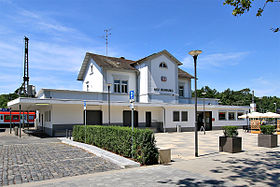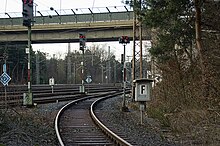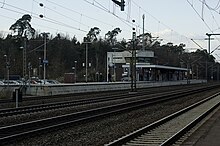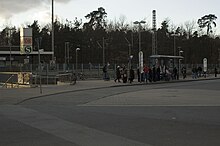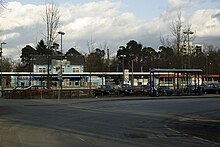Neu Isenburg station
| Neu Isenburg | |
|---|---|
|
Reception building
|
|
| Data | |
| Design | Through station |
| Platform tracks | 3 |
| abbreviation | FNIS FNISU (S-Bahn) |
| IBNR | 8004246 |
| Price range | 4th |
| opening | November 1, 1852 |
| location | |
| City / municipality | Neu-Isenburg |
| country | Hesse |
| Country | Germany |
| Coordinates | 50 ° 3 '10 " N , 8 ° 39' 57" E |
| Railway lines | |
|
|
| Railway stations in Hessen | |
The Neu-Isenburg train station is a railway station in Hesse . It was put into operation on November 1, 1852 and is now served by the Rhein-Main S-Bahn and regional trains of the DB Regio . From May 29, 1961 to October 25, 2014, it was the only Hessian train station to have a loading terminal for motorail trains (AZ). It also has two bus stops, a taxi rank and a park + ride car park.
location
The train station is located on the western edge of Neu-Isenburg at the end of Bahnhofstrasse - around two kilometers from the city center. It is located on the railway line with VzG number 3601 ( Main-Neckar-Bahn ), which connects Heidelberg Central Station with Frankfurt (Main) Central Station .
There is a taxi stand on the east side of the station and a park + ride car park has been created on the west side .
There is also a restaurant , a kiosk and a video travel center in the station building .
history
Emergence
When the Main-Neckar Railway went into operation on August 1, 1846, the Neu-Isenburg stop did not yet exist. In order to benefit from the economic importance of the railway, citizens of Neu-Isenburg (including the innkeeper Friedrich Engel and the local Schneider Wittich) submitted several submissions to the Grand Ducal Hessian Ministry of Finance in Darmstadt , which was responsible for transport at the time, a. These submissions were initially rejected. Only at the beginning of 1852 was the request granted and on November 1, 1852 the Isenburg train station was opened. Initially, only a few used the new train station. In statistics from 1852/1853 it was noted that “107 guilders and 15 cruisers were collected for the transport of people, animals and luggage”.
Initially, the station consisted of only a station keeper's house , which was replaced by a station building in the course of the laying of the second track in autumn 1861. A year later the station was equipped with a telegraph .
extension
At the end of 1873 two shunting tracks and a siding were added to the brickworks of Philipp Holzmann & Cie. Built in the same year . KG put into operation, which gave the city an economic upswing. All of the switches required for this first had to be operated manually on site. The first signal box was not built until 1876, from which the points could be set by wire connections. In 1893 the signal box was replaced by the "central turnout and signal box on a signal tower " called Isb .
In 1894 the station received its first electric lighting. In 1900, the operation of the northern shunting track was discontinued due to the freight yards on the route to Darmstadt that had been created in the meantime . By then, the station's transport capacity had grown to 100,000 people and 45,000 tons of freight per year.
In 1903, a branch line from Neu Isenburg station to the city of Neu-Isenburg was put into operation, but it was only used for freight traffic. The consequence of this was that the express and general cargo traffic to Isenburg station (today: Neu Isenburg) was discontinued and was now handled in Neu Isenburg station (later: Neu Isenburg Stadt). The branch line has not been used since the end of 2003 and was shut down in 2006 .
In 1904 a second signal box named If was put into operation. On October 1, 1907, the station, together with the branch line to Neu-Isenburg Stadt, was transferred from the jurisdiction of the Mainz Railway Directorate to the Frankfurt Directorate.
Interwar period
In the course of the occupation of the Ruhr area by French troops in 1923, Neu-Isenburg station was requisitioned and Germans were no longer allowed to enter. Since many Isenburg residents were dependent on the rail connection, an emergency station was set up by local railroad workers in the unoccupied area of the city of Frankfurt, which is only 400 meters away from the station. It consisted only of a wooden hut for the sale of tickets and a plank crossing , which ensured a reasonably safe getting on and off. The provisional arrangement did not end until the French troops withdrew in September 1924.
During the Second World War , the city of Neu-Isenburg and its train station were repeatedly exposed to heavy air raids , in which - in contrast to other train stations in the area - the station building remained undamaged and only parts of the track system were damaged, but repaired quickly after the end of the war.
German Federal Railroad
In the early 1960s, the Deutsche Bundesbahn decided to connect the Rhine-Main area to the international car train network. She chose Neu-Isenburg station for this. The first motorail train stopped here on May 29, 1961. This made the station internationally known. In 1968 the car loading facility was given a second track.
On April 14, 1969, the Isb and If signal boxes were combined in a new If signal box , which also took over the tasks of the Bf and Bn signal boxes in Dreieich-Buchschlag . It is an electrical interlocking of the type Sp Dr S 60 ( track plan - push buttons Siemens 1960). The plant is still in operation today.
In 1983, shunting operations at Neu-Isenburg station were discontinued. Since 1997, the station has served as a stop for S-Bahn traffic.
Accidents
In 1882, the lantern of a worker walking past ignited ether haze , which poured out of a parked car filled with ether. The car and a nearby truck loaded with cotton were destroyed.
In 1892 two freight wagons derailed and tore up all the telegraph lines connecting Frankfurt and Darmstadt.
In the last days of the war in 1945, the dispatcher on duty left the signal box in anticipation of an air raid to go to the air raid shelter. Before that, he released the entry signal for a train from Frankfurt on platform 3, without thinking that this platform was still occupied by a passenger train. The collision of the trains left almost 40 dead.
In October 1958, an express train caught two cars standing on the level crossing that was still in existence at the time .
In 1979 a passenger train derailed for unknown reasons. There were no injuries, but there was property damage of 150,000 DM.
The last accident so far occurred on March 25, 2008. When coupled together, two car transporters drove too quickly onto the waiting passenger cars. Fourteen people were injured.
service
Regional traffic
The station is served by the Rhein-Main S-Bahn and regional trains (RB) 61.
The S-Bahn lines S3 and S4 serve the station every half hour on weekdays, which results in a 15-minute cycle due to the overlap. On Sundays the S3 also runs every half hour, the S4 already ends in Frankfurt (Main) Süd .
The trains of the RB 61 run every hour between Frankfurt Hauptbahnhof and Dieburg, until 2016 this line only stopped at Neu-Isenburg station in the morning and afternoon. In addition, since September 2016, the trains of the Dreieichbahn, which run every hour Monday to Friday and which have ended in Dreieich-Buchschlag, have been extended to Neu-Isenburg.
| Rhein-Main S-Bahn | ||
| Previous station | line | Next station |
|---|---|---|
|
Frankfurt-Louisa ← Bad Soden (Taunus) |
|
Dreieich-Buchschlag Darmstadt Hbf → |
|
Frankfurt-Louisa ← Kronberg (Taunus) |
|
Dreieich-Buchschlag Langen → |
(As of 2019)
Car train
The station has a loading ramp for DB Fernverkehr car trains . Around 10,000 vehicles were loaded at the motorail terminal during the summer season. The passengers themselves drove the vehicles onto the two-story car transporter via an asphalt ramp . The drivers were then able to leave the wagons using special platforms set up on the track. In the first 25 years of the car train terminal in Neu-Isenburg, over 200,000 vehicles were processed. After the train arrived, the loaded wagons were attached to the train and the passengers could get into the sleeping and couchette cars. Trains ran from Neu-Isenburg to Narbonne in France , Alessandria and Verona in Italy and Villach in Austria . A glazed waiting room on the south side of the station building was available to travelers for waiting times. On October 25, 2014 a motorail train ran for the last time from Neu-Isenburg (AZ 53371 to Narbonne / AZ 73371 to Alessandria); On October 26, 2014, a car train last arrived in Neu-Isenburg (AZ 53370 from Narbonne / AZ 73370 from Alessandria). That ended an era.
Transportation
There are two bus stops that are served by transport companies in the Rhein-Main-Verkehrsverbund (RMV). The bus stop Bahnhof Westseite connects Neu-Isenburg train station with Terminal 1 at Frankfurt Airport , Obertshausen train station (line 651) and Rödermark - Urberach (line OF-95).
Buses to Darmstadt-Arheilgen (line 662) and Mörfelden via Langen (line 663) run from the Ostseite bus stop .
The OF-51 runs depending on the time to the east side - then as the final stop - or via the west side to Zeppelinheim station and in the opposite direction to Gravenbruch .
Regional bypass West
The Regional Tangent West (RTW) is a planned regional light rail line in the rapid transit network of the Rhine-Main area . It is intended to connect the cities of the Hochtaunus and Main-Taunus districts with Frankfurt and Neu-Isenburg airports .
The plans envisage that the Neu-Isenburg train station and two further - still to be built - stops (industrial area West and Isenburg-Zentrum ) will be connected to Neu-Isenburg's urban area. For this purpose, the already existing and temporarily closed junction to Neu-Isenburg is to be reactivated. In addition to the extension coming from the north from the Main-Neckar railway, an extension coming from the south is also to be built. Branching off from the Main-Neckar-Bahn, the route is to run on a single track into the city center of Neu-Isenburg as far as the former Neu-Isenburg freight station, so that the route does not have to be expanded to two tracks. At the end of the line, the Isenburg-Zentrum stop is to be built with a double-track turning system . In order to plan either a train or a dual-system light rail to Karlsruhe model to be run on the existing line, the route has electrified be.
Topological track plan

The Main-Neckar-Bahn runs on four tracks between Frankfurt-Louisa and Dreieich-Buchschlag. In front of the Neu-Isenburg station, a track is being laid out, which will become track 1 in the station. Behind the Neu-Isenburg station, the four eastern tracks (on the track diagram below) are re-threaded into the main line.
The two western tracks (on the track diagram above) are station tracks 3 and 2. They are used for S-Bahn traffic. The next two tracks belong to route 3688, are used for long-distance and freight traffic and run through the station without a platform edge. Railway station track 1 is part of route 3688. This is where the regional train runs between Dieburg and Frankfurt. East of track 1 are the tracks of the motorail train terminal (FNISA) at the end of which is the ramp via which motor vehicles are loaded onto the car transporter.
literature
- Mathias Tank: Neu-Isenburg station - a train station makes a career . ztv-Verlag, 1984, ISBN 3-923597-11-8 .
- Gerhard H. Gräber, Claudia Lack, Reinhard Zimmermann: Time leaps in Neu-Isenburg . Sutton Verlag, 2005, ISBN 3-89702-798-4 .
- Heidi Fogel: Neu-Isenburg on the way from the village to the city at the turn of the 19th to the 20th century . Magistrate of the City of Neu-Isenburg, 1994.
Web links
Individual evidence
- ↑ Station category list 2017 (PDF; 343 KiB) DB Station & Service AG , December 16, 2016, accessed on May 24, 2017 .
- ^ Mathias Tank, Neu-Isenburg railway station - A railway station makes a career, p. 79
- ↑ Personalnachrichten, p. 166. In: Eisenbahndirektion Mainz (Ed.): Collection of the published Official Gazettes 7 (1903). Mainz 1904. Official Journal No. 16 of March 21, 1903.
- ↑ Eisenbahn-Directions district Mainz (ed.): Official Gazette of the Royal Prussian and Grand Ducal Hessian Railway Directorate in Mainz of September 21, 1907, No. 47. Announcement No. 499, p. 491 and of September 26, 1907, No. 48. Announcement No. 506, pp. 495f.
- ^ Report of the Frankfurter Allgemeine Zeitung on March 25, 2008
- ^ Timetables of Stadtwerke Dreieich. (PDF) Retrieved July 30, 2016 .
- ↑ Dreieichbahn now runs to Neu-Isenburg. In: op-online.de. September 15, 2016, accessed October 11, 2016 .
- ^ France current times ( Memento from June 19, 2012 in the Internet Archive )
- ↑ The end of an era: a motorail train is loaded for the last time
- ^ Off for the motorail train
- ↑ a b Regional land use plan of the planning association for the Frankfurt / Rhine-Main urban area 2007
